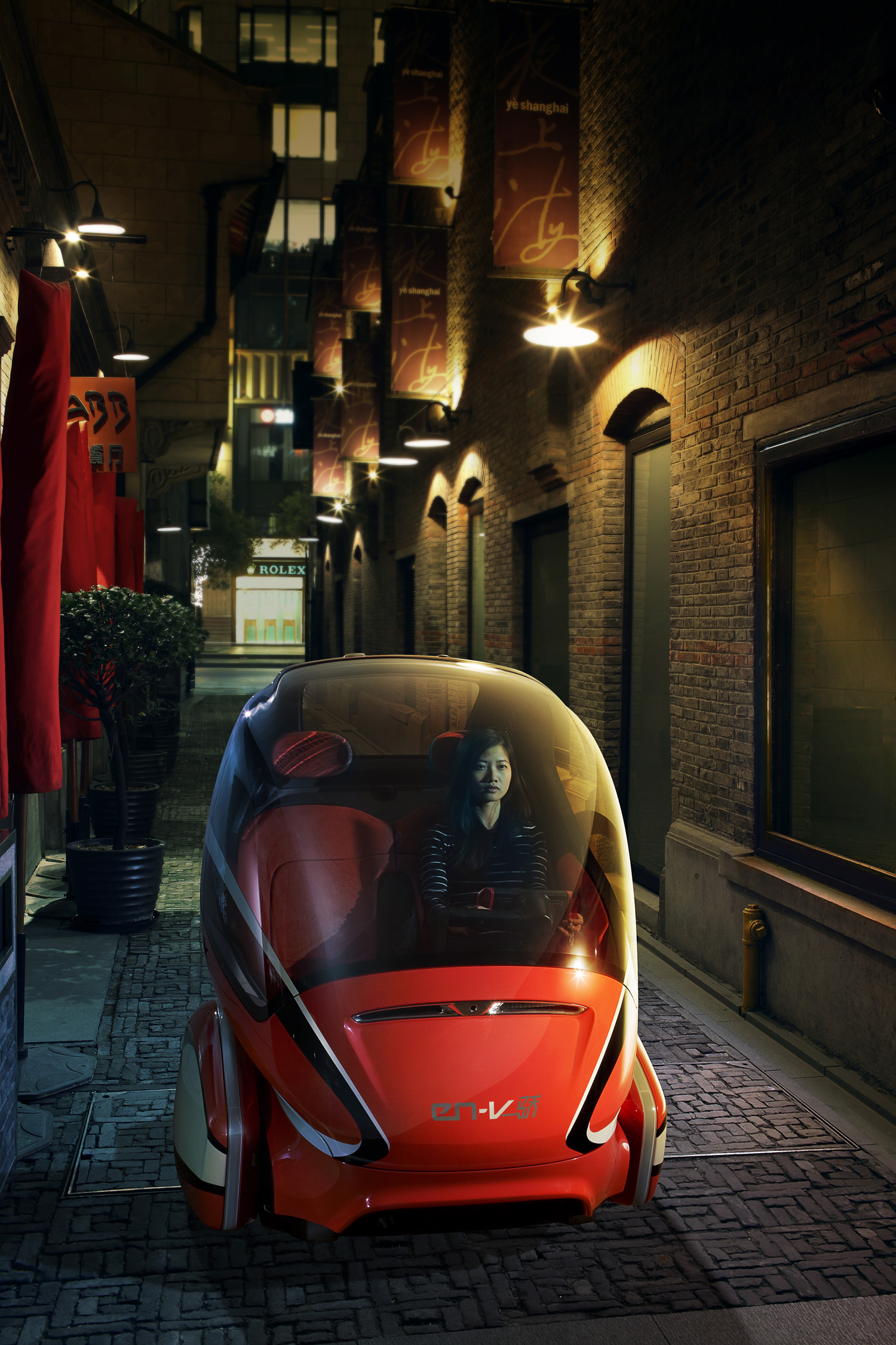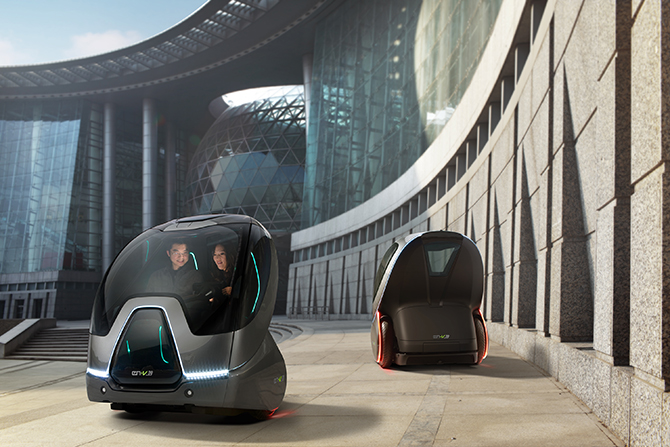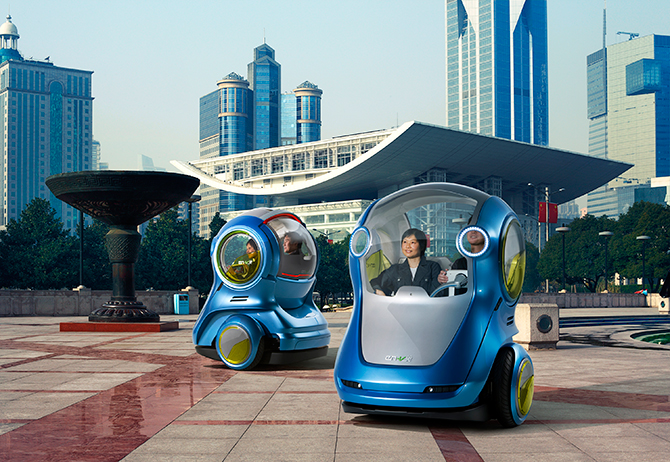Meet GM’s new EN-V , the transporter for 2030 is sleek, electric & automated
(Sources: Wired; RTTNews, Associated Press, The Detroit News GM Press Release)

Image Courtesy: GM
General Motors always dreams big, no matter how much money they have in their bank account. Now that Uncle Sam’s treasury is backing up the financial future, GM continues its tradition of dreaming big and the latest outcome of this is a future where people navigate crowded cities in big Segways that look kinda like a Dyson vacuum cleaner and can drive you home when you’ve had one too many after a long day at work. . Seriously.
Today, GM unveiled a trio of electric “urban mobility vehicles,” built with help from the über-geeks at Segway, today in Shanghai. They’re called Electric Networked Vehicles (EN-V) and they’re designed for cities bursting at the seams with traffic. The EN-V, pronounced “envy,” is GM’s latest effort to burnish its credentials as a future-focused, environmentally friendly company and shed its image as the bastion of the gas guzzling Hummer. The automaker is in the process of winding down Hummer after a deal collapsed to sell it to a Chinese heavy equipment maker. The helmet-shaped two-seater vehicles unveiled today in Shanghai will be now showcased at world expo 2010 to be held in Shanghai starting May 1 through October 31. The pavilion will be shared by GM with its Chinese partner SAIC Motor Corp. There will be three models on display in Shanghai:
unveiled today in Shanghai will be now showcased at world expo 2010 to be held in Shanghai starting May 1 through October 31. The pavilion will be shared by GM with its Chinese partner SAIC Motor Corp. There will be three models on display in Shanghai:
- Red – Jiao, or Pride – Created by designers at GM Europe, the vehicle was influenced by bullet trains and Chinese opera masks.
- Black – Miao, or Magic – Sculpted by designers at GM’s Advanced Design Studio in California and influenced by the consumer electronics industry’s sleek, masculine looks.
- Blue – Xiao, or Laugh – Created by GM Holden’s designers in Australia, who took a more lighthearted approach to the vehicle’s “gumball blue” paint and nautical design.
Shanghai is the perfect place to show the funky runabouts because China is the largest automobile market on the planet. A lot of thought is going into figuring out how all those people buying all those cars will get around. Sixty percent of the world’s population will live in urban areas by 2030 and there will be 2 billion cars on the road. Automakers are looking for ways to build cars that pollute less and take up less space.
Here are some interesting nuggets gleaned from the above sources:
- To that end, the two-seater concepts are about one-sixth the size of a conventional car.
- They’re made of lightweight materials like carbon fiber and weigh just 1,000 pounds apiece. GM says you can squeeze five of them into a single parking space.
- The 1.5 meter by 1.5 meter (about 5 foot by 5 foot) EN-V appears to build on GM’s earlier work with Segway Inc. in developing the Personal Urban Mobility and Accessibility (PUMA) concept vehicle. It will use the same types of battery cells as the Segway and the same battery supplier, Valence Technology Inc.
- The propulsion technique employed in the prototype was, however, introduced earlier by GM on its Hy-wire concept, introduced at the Paris Motor Show 2006. The forward-thinking concepts build upon we saw last year in New York.
- Powered by Lithium-ion batteries and enriched with capabilities like dramatically smaller turning radius, the zero-emission vehicle is designed to travel at least 40 kilometers on a single charge.
- GM notes that the operating costs are one-fifth to one-sixth the price of a conventional motor vehicle and one-third to one-fourth the operating cost of a passenger car.
- The EN-Vs are super-connected. They’ll use GPS, distance-sensing technology and vehicle-to-vehicle communications to ease congestion and reduce the risk of accidents. GM says the vehicles can “sense” what’s around them and react quickly to obstacles or changes in driving conditions.
- There’s a motor in each wheel and a lithium-ion battery. It’s got “dynamic stabilization technology” so it can balance on two wheels, and GM says it can “literally turn on a dime.” It also says the vehicles have a range of 25 miles and a top speed of 25 mph, which it says is more than adequate for daily city driving.
- There will be an estimated 1.2 billion vehicles worldwide in 2030. That’s up from 844 million three years ago, according to the Motor & Equipment Manufacturers Association.
- People living in major cities will have a more difficult time commuting because in 20 years, 60 percent of the world’s population will live in urban areas, according to GM.
- In major cities, 30 percent of fuel is wasted while drivers hunt for parking spots, which adds to the cost associated with operating vehicles.

Click here for some interesting pictures and a detailed scoop. If you are interested in reading more about the concept and have the time to enjoy some cool videos that demonstrate the technology and vision, click here.
Related articles by Zemanta
- GM Previews EN-V Mobility Concepts Ahead Of 2010 Shanghai World Expo (thecarconnection.com)
- GM Pod Car Looks Like a 2-Wheeled Vacuum (wired.com)
- GM’s EN-V concept car: auto redo for green future (seattletimes.nwsource.com)
- GM’s two-seater EN-V concept makes ‘urban mobility’ hip again (engadget.com)
- They’re Also Known As…: (brothersjuddblog.com)
- GM Unveils EN-V Concept Vehicle (ubergizmo.com)
- GM unveils three futuristic, urban EN-V concepts (autoblog.com)
- GM EN-V Concept Car Could Fit Into An Apartment (huffingtonpost.com)
- Is it a bike, is it a car? GM debuts electric mini-vehicle concept car (businessgreen.com)
- GM floats autonomous two-seater city car idea (news.cnet.com)

![Reblog this post [with Zemanta]](http://img.zemanta.com/reblog_e.png?x-id=b995a12a-5a9b-49ff-9e3e-34c5e676041d)



